School’s Out for Summer

It’s that time of year again, when all around the UK thousands of school children breathe a sigh of relief…….whilst parents take a large intake of breath, in preparation for the long 6 to 8 weeks that lie ahead! Whilst the summer holidays bring lots of opportunities for fun, with days spent playing in the sunshine, so too can they bring numerous opportunities for accidents and injuries!
Local organisation Trainingly have put together a special First Aid Summer Guide which features common injuries your child or children you are looking after may experience whilst having fun and enjoying the sunshine and how to respond from a first aid perspective.
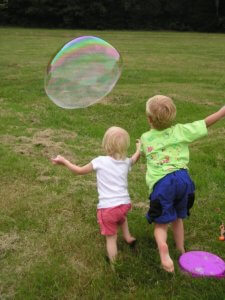
Garden Adventures and Trips to the Playground
Nothing can beat the freedom that summer brings in terms of being able to run around in the great outdoors! Whether in the safety of your own garden, the local park or your favourite National Trust estate, lots of children running around and having fun can often lead to potential injuries. With a few basic first aid skills you can have them up on their feet and running around again before you know it….
Cuts and Grazes
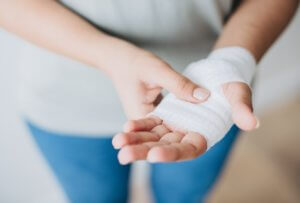 Few children escape the summer holidays without acquiring a few cuts and grazes. These are relatively simple and easy to manage at home using the following first aid steps.
Few children escape the summer holidays without acquiring a few cuts and grazes. These are relatively simple and easy to manage at home using the following first aid steps.
Stop the bleeding
- Apply pressure to the affected area using a clean and dry absorbent material i.e. a towel or bandage
- If the cut is to your hand or arm, apply pressure for a minimum of ten minutes to control the bleed
Clean the wound and apply a dressing
When the wound has stopped bleeding, clean it and cover it with a dressing. This helps to reduce the risk of infection.
- Wash and dry your hands
- Clean the wound under drinking-quality running tap water. Avoid using antiseptic as it may damage the skin and slow down the healing process.
- Pat the area dry with a clean cloth
- Apply a sterile, low adherent dressing
- Keep the dressing clean by changing it as often as necessary. Do not let the wound become exposed to water.
- Remove the dressing after a few days, once the wound has healed itself.
When cuts and grazes become more serious….
It’s time to take action and seek medical advice if you cannot stop the wound from bleeding or there appear to be signs of infection. This is more likely if dirt or a foreign body becomes embedded in the wound.
Signs of infection are:
- Swelling, redness and pain in the affected area
- Collection of pus in or around the wound
- A high temperature of above 38 degrees C
- Feeling lethargic and generally unwell
- Swollen glands under the chin, in the neck, armpits or groin
Seek medical help immediately on the first signs of infection!
Head Injuries
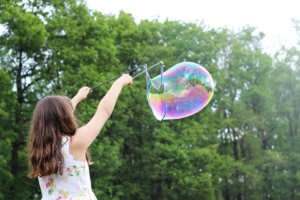 When children are running around there are always going to be the odd bump to the head or two! Most head injuries are minor and do not require medical attention. The first aid response is as follows:
When children are running around there are always going to be the odd bump to the head or two! Most head injuries are minor and do not require medical attention. The first aid response is as follows:
- Sit the child down
- Apply something cold (cold compress or ice wrapped in a tea towel) to the injured area to reduce swelling and pain
- Monitor the child for signs of a more severe head injury, especially if you did not witness the incident taking place
If the child’s symptoms get worse take them straight to A&E or call 999 for an ambulance. Look out for the following signs of a more severe head injury:
- Fatigue or drowsiness
- Unconsciousness (either brief or for a longer period of time)
- Fits or seizures
- Problems with the senses; hearing loss or double vision
- Repeated vomiting
- Blood or clear fluid coming from the ears or nose
- Memory loss (amnesia)
Sports in the Sunshine
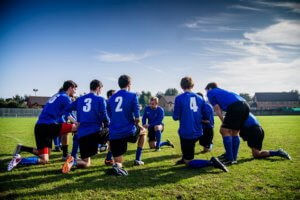 All that time spent running around in the park playing cricket, football or Frisbee in the park are great ways to keep active, whilst enjoying the summer sun. However, running around makes you sweat, and getting too dehydrated can be harmful, especially if you aren’t drinking enough!
All that time spent running around in the park playing cricket, football or Frisbee in the park are great ways to keep active, whilst enjoying the summer sun. However, running around makes you sweat, and getting too dehydrated can be harmful, especially if you aren’t drinking enough!
Heat exhaustion
Heat exhaustion happens when someone loses too much fluid and salt from sweating in hot conditions. If a person has heat exhaustion, they may:
- Feel dizzy or confused and complain of a headache
- Be sweating and have pale, cool skin
- Feel nauseous
First Aid Response
- Help them to a cool place and get them to rest. This will help them start to cool down
- Give them plenty of water to drink. Isotonic sports drinks are even better as they will also help replace the salts lost through sweating
- Seek medical advice. Even if the person appears to recover fully, they should seek medical advice. If their condition gets worse, call 999 for emergency help.
Heat Stroke
Heat exhaustion can quickly develop into heat stroke, which is far more serious and can even be life-threatening:
- Headache
- Restlessness and confusion
- Hot, flushed and dry skin
- A fast deterioration in the level of response
- A full and pounding pulse
- A body temperature above 40C (104F)
First Aid Response
- Quickly take the casualty to a cool place and remove outer clothing
- Call 999 for an ambulance
- Wrap them in a cold, wet sheet or towel and keep pouring water over it until their temperature falls to at least 38C (100.4)
- If you cannot find a sheet or towel, fan them or sponge them down with cold water
- Once their temperature has gone back to normal, replace the wet sheet or towel with a dry one
- Monitor their temperature, breathing, pulse and level of response whilst you wait for help
- If they start to get hot again, repeat steps above to lower their temperature
- If they start to lose responsiveness, open their airway, check breathing and prepare to administer CPR if they become unresponsive
Nose Bleeds
Another hazard of ball games are nose bleeds. Whilst most are minor and only last a few minutes, they can be dangerous if someone loses a lot of blood. With all nosebleeds the priority is controlling the bleeding and keeping the airway open. Follow the simple first aid steps below:
- Get them to sit down (not lie down). Keeping the nose above the heart reduces the bleeding
- Lean them forwards (not backwards) to make sure the blood drains out through their nose and not down their throat, which could block their airway
- Ask them to breathe through their mouth and pinch the soft part of the nose, taking a pause every ten minutes, until the bleeding stops
- Encourage them not to speak, swallow, cough, spit or sniff. This may break blood clots that may have started to form in the nose
- If the bleeding is severe or lasts more than 30 minutes, call 999 for emergency help
If the nosebleed has been caused by a blow to the head and appears thin and watery, this could mean that the skull is fractured and fluid is leaking from around the brain. Call 999 immediately as emergency medical help is required.
Picnics in the Park
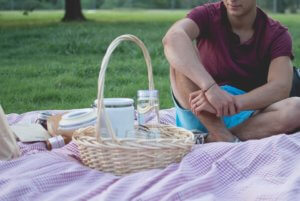 It’s hard to enjoy a picnic in the park without the unwanted visit by a wasp or too! If you can, try and encourage your child to stay calm and not flap their hands around as this can aggravate the wasp more, increasing the risk of being stung. If a sting does occur follow the simple first aid steps below:
It’s hard to enjoy a picnic in the park without the unwanted visit by a wasp or too! If you can, try and encourage your child to stay calm and not flap their hands around as this can aggravate the wasp more, increasing the risk of being stung. If a sting does occur follow the simple first aid steps below:
- If the sting is visible on the skin, use the edge of a credit card to scrape it away
- Wash the affected area with soap and water
- Raise or elevate the affected area if possible, as this can help reduce swelling
- Apply an ice pack (wrapped in a tea towel or triangular bandage) for at least 10 minutes
- Avoid scratching the area to reduce the risk of infection
Antihistamines can help to reduce the swelling and itching but always seek advice from your pharmacist regarding over-the-counter treatments.
Insect bites can be triggers for Anaphylaxis, an extremely dangerous allergic reaction. Keep an eye out for symptoms:
- Difficulty breathing
- A fast pulse
- Dizziness or feeling faint
- Blotchy skin rash/flushing
It is important to note that not all these symptoms maybe present.
For more First Aid advice and information you can try a Trainingly First Aid Course or follow them on Facebook and Twitter.
